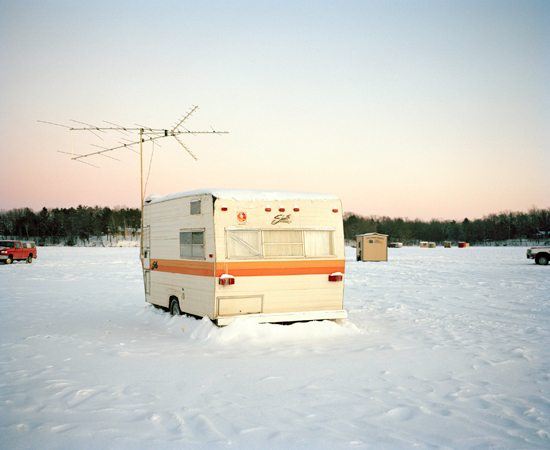
Image credit: From Maureen R. Drennan
H/T to Artist as Citizen Burning Embers Competition
This series of photos by Maureen Drennan resonates with the way I have been thinking about environmental activism. The photographs tell a story of ice-fishing communities in Northern Wisconsin and Minnesota and depict ordinary ice-fishers: bright-eyed children over plastic gallon fishing buckets, seasoned fishers in pullovers and camouflage, and bright cabins in contrast to the winter white. There are also pictures of cracks in the ice.
As the photographer writes, ice fishing is decreasing with global warning, which impacts sub-cultures of fishers, losses of community as well as economic losses.
Recently, I have been thinking we need incisive, creative visualizations of ecological crisis. Mainstream ‘green’ imagery seems (to me, lately) way too benign. Do swirling, interconnected arrows really cause people to recycle? Do they have a limited function? Are muted greens and browns the right palate for motivating owners of industrial companies across the world, who need to decrease polluting?
On DotEarth, the New York Times environmental blogger Andrew C. Revkin is promoting ideas that relate to mine. This month Revkin features the work of four designers, Drennan’s photos and three other visualizations about ecological crisis from the Art as Citizen/DotEarth project Burning Embers Competition. Revkin not only featured the artist/designers, for he also inspired the project with a proposal for illustrations about climate risk in an earlier post. It is interesting that Revkin's proposal was answered, and it is also interesting the kinds of images created.
Drennan’s photos were quite different from a chart, or a visualization based on numerical data. She measures climate risk against some other kind of scale. Her images of people in their threatened environment point out the interpersonal connections and practices that will be lost with global warming. Is this a more effective picture? What are the audience for Drennan’s as opposed to the other images? Look for an interview with Drennan on Viz. in the coming weeks.

Recent comments
2 years 29 weeks ago
2 years 44 weeks ago
2 years 44 weeks ago
2 years 50 weeks ago
3 years 4 weeks ago
3 years 4 weeks ago
3 years 4 weeks ago
3 years 6 weeks ago
3 years 6 weeks ago
3 years 6 weeks ago